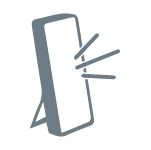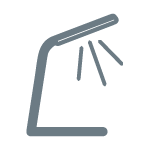December 2020 | Reviewed by: Shelley Hershner, MD and Reeba Mathew, MD
What is bright light therapy?
Bright light therapy is a treatment for people who have circadian rhythm sleep disorders. Your body has an internal clock that tells it when it is time to be asleep and when it is time to be awake.
This clock is in the brain just above an area where the nerves travel to the eyes. This area is called the suprachiasmatic nucleus or SCN. Your clock controls the circadian rhythms in your body. These rhythms include body temperature, alertness and the daily cycle of many hormones.
The word “circadian” means to occur in a cycle of about 24 hours. Circadian rhythms make you feel sleepy or alert at regular times every day. Some people have a circadian rhythm sleep disorder. This causes their natural sleep time to overlap with regular activities such as work or school.
One thing that “sets” your internal clock is exposure to bright light such as sunlight. Light therapy is used to expose your eyes to intense but safe amounts of light for a specific and regular length of time. In many places, sunlight is not available at the proper time to be used as treatment. Artificial light may be used to affect the body clock in the same way that sunlight does except we often get exposed to artificial light when we normally have darkness.
Light therapy can help someone “reset” a clock that is off. Regular sleep patterns help to keep the clock set at the new time. Light therapy is one part of a treatment plan that should be guided by a sleep doctor.
What are the types of bright light therapy?
Currently, products used for light therapy fit into four basic groups:

Light box
This is the most common tool for light therapy. The box houses several tubes that produce extremely bright light. It sits on top of a table or desk and plugs into the wall.
During a treatment session, you must keep within a certain distance of the box, usually 18 to 24 inches. It does not require you to look directly into the light. Instead, you simply face in the direction of the box.
You can do other activities during the session. Ideally, you would work on papers, computer or read something that is in the lit area. This will allow the light to be received by your eyes. Your body takes in this information and uses it to regulate the rhythms that control when you sleep and when you wake up.
Early models of light boxes put out 2,500 to 5,000 lux of light. Lux is a measure of how much light falls on your eyes. These sessions could take two or three hours. The newer light boxes produce 10,000 lux of light. This allows sessions to take as little as 15 to 30 minutes.
New models are also safer, protecting you from harmful UV rays. Some models are now focusing on a specific bandwidth of light. Light boxes can be purchased in a variety of makes and models. Some are now being made much smaller, so they are easier to take with you.

Desk lamps
This serves the same purpose as a light box, but it is made to look like a normal lamp. It blends in better when used in an office setting.

Light visor
This is a light source that is worn on your head and hangs over your eyes. It looks much like a tennis visor. It is made so that you can move around during sessions. The strength of visor lights varies from 3,000 to 10,000 lux.

Dawn simulator
These lights gradually make a dark room brighter over a set amount of time. This is meant to mimic the sunrise. Some people find that this helps them wake up in the morning. Models may also slowly dim to copy a sunset.
What disorders are treated with bright light therapy?
Delayed sleep-wake phase disorder
This disorder causes you to fall asleep much later at night than is normal. As a result, you also wake up later in the morning. This sleep pattern can interfere with morning activities. You might miss class or be late to work. To correct this disorder, use bright light therapy soon after waking up.
Advanced sleep-wake phase disorder
This disorder causes you to fall asleep much earlier at night than is normal. You also wake up earlier in the morning, sometimes as early as 3:00 or 4:00 a.m. To correct this disorder, use bright light therapy early at night.
Free-running or non-24-hour sleep-wake rhythm disorder
If you have this disorder, you fall asleep at a later time each day. For example, you may fall asleep at 10:00 p.m. one day, midnight the next day, and 2:00 a.m. the next. This most often occurs in people who are blind. Bright light therapy may help blind people, even if they can’t perceive visible light. Studies show that light treatment may be useful in the early morning hours.
Jet lag
Jet lag causes you to have problems with sleep when you have crossed many time zones on a flight. Bright light therapy in the morning may help when traveling east. For travel to the west, bright light therapy in the evening may help reduce jet lag.
Shift work disorder
This disorder occurs due to a work schedule, such as night shift, that takes place during the time when most people are sleeping. This schedule requires you to work when your body wants to sleep. Then you have to try to sleep when your body expects to be awake. Correcting it can be hard. Changing work schedules, days off and social activities can alter your exposure to light from day to day. Frequent changes in your sleep times make it hard to reset your internal clock. In general, using bright light therapy in the evening should help someone who regularly works nights. In this case, you would also want to avoid daylight when you end work and go to bed. Dark sunglasses or special goggles can help.
What are the possible side effects of bright light therapy?
Light therapy has a good record of safety. It does not seem to produce any major side effects. Light therapy should always be used within the proper limits for intensity and time. Minor side effects may include the following:
- Eye irritation and dryness
- Headache
- Nausea
- Dryness of skin
To reduce these side effects, begin the light therapy very slowly. Give your body time to get used to it. The use of a humidifier can also help with irritation caused by dryness. Talk to your doctor or a sleep specialist before starting light therapy.
